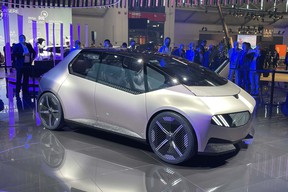BMW uses hometown advantage at 2021 IAA to show off FCEV, concept
The automaker's i Vision Circular is the car designed to be recycled—but the new 2 Series bowed, too, if you're not ready to go green just yet

Article content
With the demise of the Frankfurt Motor Show, Europe’s IAA has switched to Munich. The re-invented exposition covers everything from automobiles to ZF transmissions, and it touches every facet between the bookends. In its first year, things were a little different, as many of the established car-makers opted out. However, Munich is home to BMW, so that company strutted its stuff big time.
Advertisement
Article content
One of the highlights was the i Vision Circular — it fits in nicely with the circular economy theme of the IAA Mobility 2021. The four-seater electric hatchback is a concept aimed at demonstrating how a car can go full circle over its life span. Yes, it is a highly futuristic both in terms of its look and the manner in which the cabin is finished. However, it does give a preview of BMW’s sustainability goal. Over the next 10 years, the company says it will put around 10 million all-electric vehicles on the road and, as of 2030, at least half of all its world sales will be electric, including those of Mini, which is slated to become a solely electric brand at that time.
The i Vision Circular has relatively small exterior dimensions, but boasts lots of usable interior space thanks to its dedicated EV platform and a smaller, lighter battery. More importantly, BMW avoided using exotic composite materials and bonded joints, instead opting for quick-release fasteners, press studs, and the like so it is simpler to recycle every part at the end of its life. Of course, in keeping with its mandate, it uses recycled aluminum and bio-based raw materials to minimize the environmental impact and reduce its carbon footprint. In the same manner, the cabin employs new bonding techniques to avoid the use of glue, which, again, simplifies the recycling process.
Advertisement
Article content
The cabin layout is a little odd, as the instrument panel has gone and the central infotainment setup has been replaced by as head-up display. It’s a little too fanciful to ever see the light of day.
Advertisement
Article content
A little closer to home, BMW showed the iX5 Hydrogen Fuel Cell. It is based on the iX5 EV, but replaces the battery with all of the workings needed to make it run on hydrogen. Up front sits the fuel-cell stack; two hydrogen tanks form a T-shape in the centre of the vehicle; and the battery sits at the back, with an electric motor driving the rear wheels.
Looking at the components on a buck showing the key parts that make up the hydrogen version, you’d think there’s no way it will all fit, but fit it does, and without any sacrifice in interior space. There is not even a reduction is cargo capacity.
Advertisement
Article content
The combination produces some serious numbers. The fuel cell – which starts at below -30 Celsius – and battery combine to supply the electricity demanded by the electric motor — it makes 369 horsepower and 516 pound-feet of torque. The tanks carry six kilograms of hydrogen, which is enough for 500 kilometres of driving.
The big plus is that when compared to a battery-electric vehicle, which can take eight hours to charge using a Level 2 charger, or a splash and go at a fast-charger in around 45 mins, the iX5 Hydrogen Fuel Cell lines up more with a gasoline-powered X5 — it takes three to four minutes to refill the tanks!
Advertisement
Article content
While there was no drive, riding in the iX5 Hydrogen Fuel Cell proved it to be a completely seamless experience. The acceleration from a standstill is brisk, with 100 kilometres an hour coming in at seven seconds. The mid-range is equally impressive. Perhaps the biggest compliment of all is the fact it feels like a normal X5, but one with all the delicious instant-on torque expected from an electrified drive. Fuel cell technology is the future, and the future feels very good as employed in the iX5 Hydrogen Fuel Cell.
During a round-table with Oliver Zipse, Chairman of the Board of Management at BMW, promised that there would be hydrogen-powered fuel cell vehicles in customer hands before the end of this decade. He did, however, stress that the delay is due, in part, to the lack of a decent refuelling infrastructure. Canada sadly lacks here — there are eight hydrogen refuelling stations in Munich alone!
Advertisement
Article content
Finally, the new 2 Series coupe surfaced. It is a premium two-door that’s based on the 3 Series platform, but with tighter dimensions. It is a very sharp-looking piece that is, in the top M240i xDrive model, going to add a real racer to the segment.
Power comes from a 3.0-litre turbo-six that makes 369 hp and 369 lb-ft of torque from 1,900 rpm. The handling comes courtesy of an M Sport suspension, M Sport variable steering, and M Sport brakes. Move inside and the cabin is marked by the heavily bolstered front seats and a cleaner look to the driver-focused cockpit. Finished in a metallic purple, it looks as sassy as say gets!


















